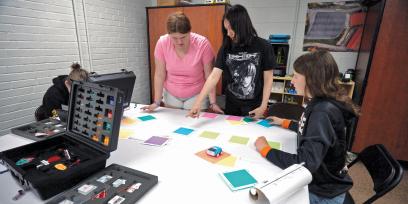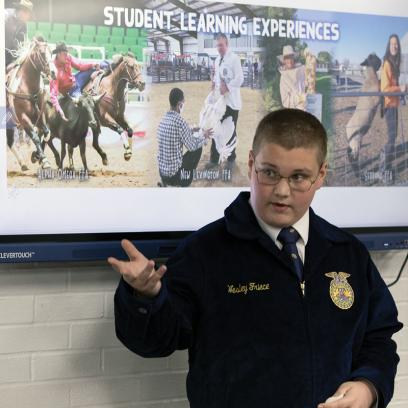Some students don’t enjoy school in the traditional sense, and they don’t see how it relates to their future. This can lead to poor academic performance, chronic absenteeism, and a high likelihood of dropping out. We are addressing this issue in many ways in New Lexington Schools, a small district serving the roughly 35,000 people of Perry County, Ohio. Our most important strategy is expanding career and technical education (CTE) and workforce development opportunities to promote high student engagement and help motivate students to stay in school and graduate.
Adding career pathways, adjusting school schedules to allow for exploration, incorporating a focus on experiential learning and exposure throughout K–12, instilling soft skills, building partnerships with the local career center and local businesses, and providing support and resources for students and their families have helped us increase performance and attendance and raise our graduation rate from 78 percent in 2018 to 92 percent in 2023.1
In 2016, while examining district data, we noticed that only about 20 percent of our students were going on to college. Realizing that we have local businesses with needs and students who aren’t going to college, we asked, “What can we do to bridge that gap so these young adults can be productive and successful in careers right out of high school in their own hometown and surrounding area?” We asked businesses in the community what problems they were having finding good employees and what we could do to prepare our students for the jobs they offered. We made a list of the essential skills that our businesses said students were lacking, such as punctuality, speaking clearly, making eye contact, perseverance, and time management. We developed a soft skills program to be taught starting in kindergarten. Businesses also said that access to a driver’s license and transportation were issues, so we brought back a driver’s education program to the high school, free of charge, because the course outside of school was too expensive for most of our students and their families to afford.
All school districts in Ohio are required to have a business advisory council to foster collaboration that will enrich students’ education and ensure employers have the workforce they need. Our council, which was awarded three-star status by the state in 2023, has grown to 62 members composed of business partners from Perry and surrounding counties. Their input helps us plan and implement the programs that will train their future employees. Right now, we’re focused on our high school students, but eventually we would like to offer adult workforce development programming in the evenings.
From Animal Husbandry to Healthcare
Our career pathways journey started with our vocational agriculture (VoAg) programming. VoAg has been part of our high school for many years. Currently, we have the second largest FFA (formerly Future Farmers of America) program in the state of Ohio.2 We have a 120-acre school farm that functions as a hands-on learning lab. Students breed and take care of pigs, sheep, and rabbits. They raise goats, turkeys, and chickens. Our farm allows students who don’t live on a farm or who can’t house an animal to experience animal husbandry. Students are entered into a lottery to take one of the farm animals to the county fair. Students do not have to pay for the animal, but they do have to commit to taking care of the animal, its stall, and its training while it resides at the farm. They are then able to show at the fair; when they sell their animal, they keep the proceeds. The farm also has a contract with Beck’s, a seed company. We are Beck’s testing plot for variations of corn seeds. The kids take soil samples and study the corn yields of the different seeds. Through all of this, they earn certifications like OSHA 10 (a safety course), forklift operation, and welding along the way.
We also have potato and pumpkin patches. The elementary students have farm field days and help plant the pumpkin patch. We also take the elementary kids on a lot of short field trips to the farm to see the sheep, pigs, chickens, and rabbits. Our high schoolers in the agricultural program teach the elementary students about the animals and how to care for them.
Our VoAg program has long been popular, so we examined how to engage more students within that pathway. We applied for and were awarded grants that allowed us to include an entry-level welding certification (American Welding Society D1.1). And, through a partnership with a local community college, our students take care of a vineyard and harvest the grapes. The local community college uses the grapes to make wine, while our students make jelly that they give away and serve at FFA banquets throughout the year.
We recently won a grant from our local Soil and Water Conservation District to build a greenhouse. We have applied for a US Department of Agriculture Farm to School grant to outfit the greenhouse with the equipment needed to grow our own fruits and vegetables year-round, which will be used in our school cafeterias. If awarded, our middle school VoAg students will lead the initiative and will help guide decision making alongside our food service entity, VoAg teachers, and middle school science teachers.
With our VoAg program thriving, we started wondering what we could do for our students who were going to the Tri-County Career Center. Tri-County is a state-approved vocational school that services several surrounding high schools, including ours, but students’ interest far outstrips the school’s capacity. Many of our students couldn’t take various programs they were interested in because there were not enough spaces. When they were able to enroll, they missed out on afterschool activities because the center is an hour away by bus.
By partnering with Tri-County, we started our own building trades program, with electrical trades embedded in our workforce building. The district provides the materials—and we have plenty of spaces for our students. This allowed our school district to obtain state CTE dollars to help sustain the program. Our students have partnered with Habitat for Humanity to help build a house within the community. The district also has a partnership with the International Brotherhood of Electrical Workers (IBEW) for electrical trades in which students train on virtual reality headsets in a virtual electrical lab and then move to an actual lab. Students will be able to interview with the IBEW upon graduation and if accepted, will start an apprenticeship at the second-year level.
Now, we have career pathways beyond agriculture and trades. Drawing from the state of Ohio’s Top Jobs website, district staff analyzed the careers that are expected to grow within our region. This analysis, as well as student surveys, helped drive the district’s vision for the future.
Many of our students are interested in healthcare careers. In conjunction with Tri-County, we started a phlebotomy program, complete with draw arms and a medical manikin for training prior to students’ first live stick. We’re currently developing a pathway for our students to obtain their licensed practical nurse credentials by the time they leave high school. That would allow them to obtain their registered nurse license in less time and enter the workforce earlier. This programming is possible through our new partnership with a local hospital that is part of Genesis HealthCare System, which has locations all over southeastern Ohio. The hospital has 750 jobs, from clinicians to IT and custodial workers, that it can’t fill right now. Through this partnership, our students can meet their clinical hours as high school students. We have a memorandum of understanding that allows students 16 years of age and older to have opportunities to intern in many careers within the hospital.
Based on our combined state job-growth and student-interest data, we’ve also expanded our CTE course offerings to include a fabrication lab, a teacher academy, media plus (which encompasses podcasting, video and photo editing, light and image processing, social media, and website design), and a drone pilot license. Our plans for the future include developing CTE pathways for advanced manufacturing, additional healthcare credentials (including respiratory therapists, x-ray technicians, and multi-skilled technicians), broadband/fiber optic technicians, and additional welding certifications.
Lessons Learned
Since we began offering CTE pathways, sustainability has been a concern. Our district is continuously looking for grants to help offset new programming costs, maintain programming, and provide or upgrade equipment. Additionally, the state of Ohio provides CTE funding tied to the number of students in each CTE class we offer, so that money comes in on our foundation payment to support our CTE programs. Ohio also offers reimbursement for each credential earned by the students. Some reimbursements are 100 percent of the cost of the credential, while others are a portion of the cost.
This process has been challenging and rewarding. While there have been bumps in the road, there have been valuable lessons learned. Partnerships are key! Whether those partnerships are with businesses or other educational institutions, they are paramount to success. Listen! Listen! Listen! Students have a voice, and when asked, they are happy to share what they are looking for. They have interests that can be explored and dreams that can be reached. And businesses have needs. Bring them into the conversation. They are willing to help build tomorrow’s workforce. Be intentional! That’s our superintendent’s favorite phrase. We have been intentional with every move in designing and bringing this vision to life. CTE is the future. It’s a way to impact students, families, and their communities in positive ways. When students are ready to take fulfilling jobs in their local communities, everyone wins.
Jenny Shiplett teaches third grade at New Lexington Elementary School and is the president of the New Lexington Federation of Teachers. Erin Schumaker is the federal programming and grants administrator for New Lexington Schools.
Endnotes
1. Ohio School Report Cards, “New Lexington High School: Graduation,” Ohio Department of Education and Workforce, reportcard.education.ohio.gov/school/gradrate/064865.
2. Data drawn from the members’ only section of FFA.org by teachers at New Lexington High School in February 2023.
[Photos by the AFT]



